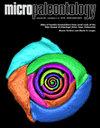底栖有孔虫Cassidulinoides parkeriana (Brady)与鲸鱼瀑布的亲缘关系:来自加拿大不列颠哥伦比亚省西温哥华岛的证据
IF 1.6
4区 地球科学
Q3 PALEONTOLOGY
引用次数: 0
摘要
在加拿大不列颠哥伦比亚省西温哥华岛(北经48.68度,西经126.84度)1288米深处观察到一具蓝鲸或长须鲸的部分骨架,估计长16.5米,据信在海底躺了不到10年。在现场采集了四个推核,三个(15-26厘米长)在尾椎骨正下方,一个18厘米长,作为15米外的参考。为了描述底栖有孔虫群落因鲸鱼下降而发生的变化。q模式聚类分析确定了四组,将鲸鱼落下和参考岩心的表层和深层样本分开。对表层样品的多维尺度图和多变量方差检验的排列分析结果也表明,落鲸区与参考岩心底栖有孔虫区系之间存在显著差异。未发现特有物种。降鲸岩心和参考岩心中6 cm以下的岩心样品主要有普通浮叶绿枝藻(Uvigerina peregrina)、太平洋假伞藻(pseudopparrella pacifica)、绿枝绿枝藻(Bolivina spissa)、纹状绿枝藻(Bulimina striata)和高枝绿枝藻(Takayanagia delicata)。相比之下,Cassidulinoides parkeriana是底栖有孔虫组合的次要组成部分,在鲸鱼落岩心上部6 cm处占主导地位,而在参考岩心中,低氧耐受性物种T. delicata占主导地位。在这个鲸鱼瀑布下面的上层沉积物中,以及在日本的鸟岛海山鲸鱼瀑布地点,parkeriana丰度的急剧增加表明,它是一个机会主义物种,很好地适应了利用不可预测的和高度本地化的热带风落,如鲸鱼瀑布。据我们所知,这是第一个底栖有孔虫物种在鲸鱼下降的情况下数量急剧增加。此外,在西温哥华岛遗址深处12至15厘米处发现的现代鲸骨碎片表明,无脊椎食腐动物食用鲸鱼尸体造成了生物扰动,这表明在鲸鱼瀑布下面的详细生物地层记录应该谨慎解释。本文章由计算机程序翻译,如有差异,请以英文原文为准。
Affinity of the benthic foraminifer Cassidulinoides parkeriana (Brady) for whale-falls: evidence from off western Vancouver Island, British Columbia, Canada
A partial skeleton of a blue or fin whale, estimated to have been 16.5 m in length and thought to have been lying on the seafloor for less than 10 years, was observed at a depth of 1288 m off western Vancouver Island, British Columbia, Canada (48.68 N, 126.84 W). Four push cores were taken at the site, three (15-26 cm in length) directly under caudal vertebrae and one 18 cm long, considered a reference, 15 m away, in order to characterize changes in the benthic foraminiferal assemblage due to the whale-fall. A Q-mode cluster analysis identified four groupings, separating the surface and deeper samples of both the whale-fall and reference cores. The results of a metric multi-dimensional scaling plot and permutational multivariate analysis of variance test of the surface samples also suggest there was a significant difference between the whale-fall and reference core benthic foraminiferal faunas. No endemic species were recovered. Downcore samples below 6 cm in the whale-fall and reference cores were characterized by common Uvigerina peregrina, Pseudoparrella pacifica, Bolivina spissa, Bulimina striata, and Takayanagia delicata. In contrast, Cassidulinoides parkeriana, which typically is a minor component of benthic foraminiferal assemblages, dominated the upper 6 cm of the whale-fall cores, whereas the low oxygen-tolerant species T. delicata dominated the same interval in the reference core. The dramatic increase in abundance of C. parkeriana in the upper sediments below this whale-fall, as well as at the Torishima Seamount whale-fall site off Japan, indicate that it is an opportunistic species well adapted to taking advantage of unpredictable and highly localized tropic windfalls such as whale-falls. To our knowledge, this is the first benthic foraminiferal species shown to increase dramatically in abundance in the presence of a whale-fall. Additionally, modern fragments of whale bones occurring as deep as 12 to 15 cm downcore at the western Vancouver Island site demonstrate the effect of bioturbation by invertebrate scavengers that consume whale carcasses, indicating that detailed biostratigraphic records below whale-falls should be interpreted with caution.
求助全文
通过发布文献求助,成功后即可免费获取论文全文。
去求助
来源期刊

Micropaleontology
地学-古生物学
CiteScore
3.20
自引率
6.70%
发文量
18
审稿时长
>12 weeks
期刊介绍:
The Journal of Micropalaeontology (JM) is an established international journal covering all aspects of microfossils and their application to both applied studies and basic research. In particular we welcome submissions relating to microfossils and their application to palaeoceanography, palaeoclimatology, palaeobiology, evolution, taxonomy, environmental change and molecular phylogeny. Owned by The Micropalaeontological Society, the scope of the journal is broad, demonstrating the application of microfossils to solving broad geoscience issues.
 求助内容:
求助内容: 应助结果提醒方式:
应助结果提醒方式:


